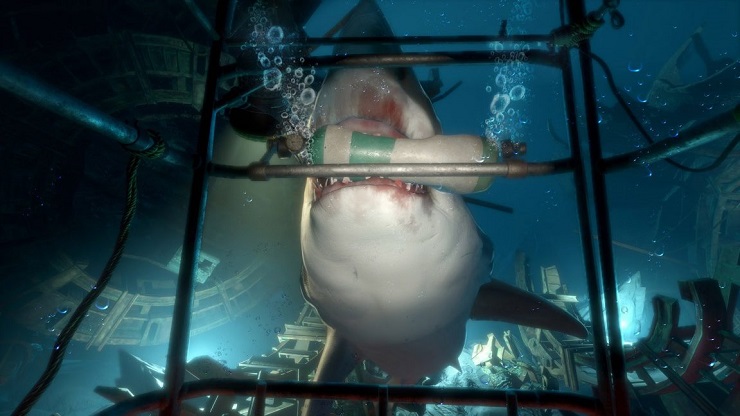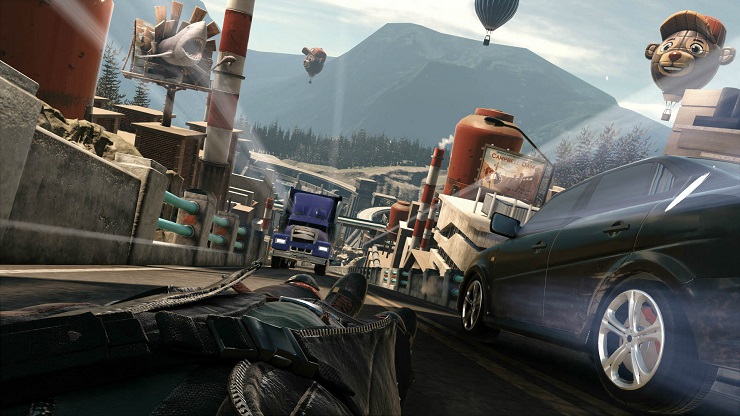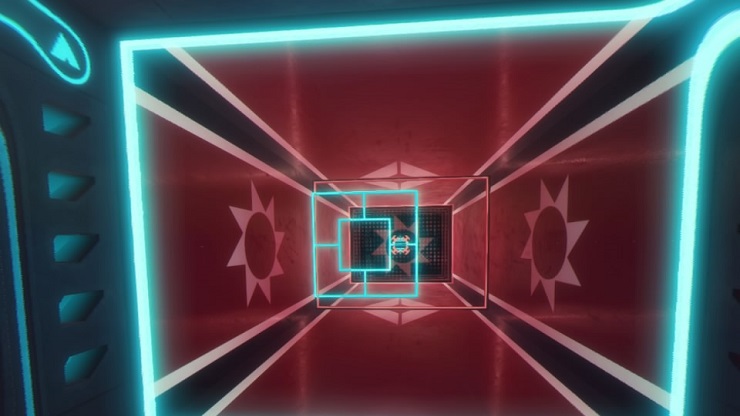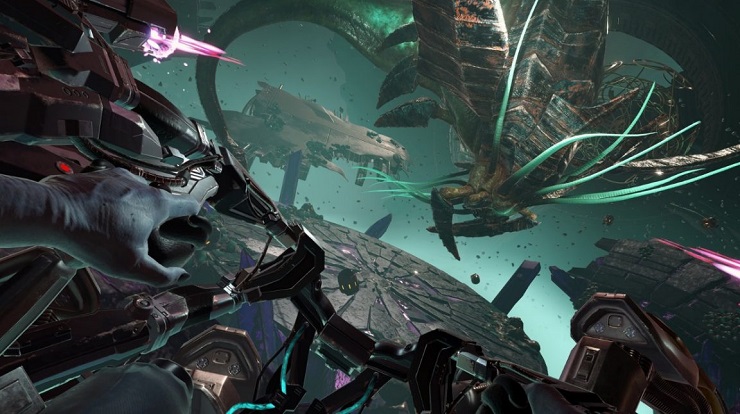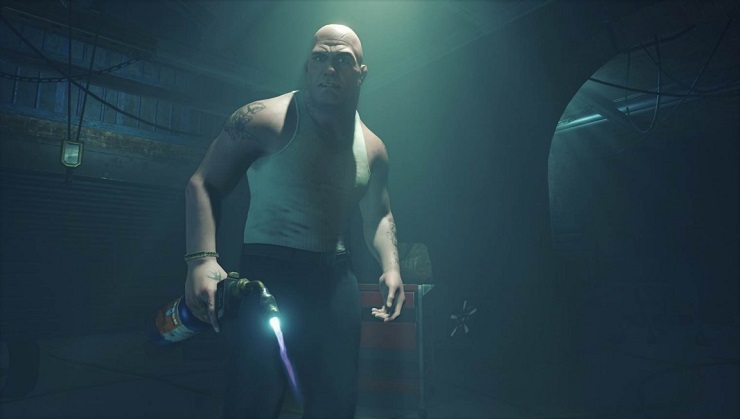The future is now upon us. After years and years of anticipation, PlayStation VR finally hit shelves this week and no doubt we’ve already lost some poor souls to the alluring world of virtual reality. That or they stopped playing from motion sickness after 20 minutes!
Either way, one of the games people may well be playing with their shiny new headsets is VR Worlds, from Sony London. VR worlds is a collection of five different games and experiences which shows off all the different things that can be achieved in virtual reality.
To get the lowdown about VR Worlds and to learn more about the challenges and future of VR, we spoke to VR Worlds Executive Producer, Brynley Gibson.
“VR Worlds is a title made up of five unique experiences and we built them all from the ground up with VR in mind and we really wanted to showcase what can be done with VR, not only to the general public but also to developers out there. Hence we’ve been doing demos throughout the entire development project, since PSVR has been announced we’ve been doing live demos. Those five experiences are very different; we went for a variety and wanted something for everyone. We wanted to show what different genres you could do, what different inputs you could use. Some use motion controllers, some use controllers and some are purely headset.”
The five games in VR Worlds are Scavenger’s Odyssey, Ocean Decent, The London Heist, VR Luge and Danger Ball, all of which use VR in different ways.
“So you’ve got Scavenger’s Odyssey, which is our core experience; it’s PS4 controlled, it’s a sci-fi cockpit shooter, but it’s got this great VR twist that you and the enemies can go upside down and on the walls. You know, it’s a real blast to play and it’s quite different. That’s very much for the core audience. Then at the other end we’ve got Ocean’s Decent, which is a more passive experience and really just like being on a nature tour – doing underwater tourism.”
Brynley’s favourite, however, is the cockney gangster story, The London Heist.
“I think the experience really lit a fire under what we were doing, in terms of the reaction it got when we started showing it to people. It was also a real labour of love, trying to work out the controls – they were super intuitive so that when people played it it all made sense, and a lot of time and effort went into it.”
“The magic moment when we see people picking up a gun and not being told how to reload it, but they know what it’s like in an action movie so they just look down, see a magazine and pick it up with their other hand and just stick it in there, and just the smile on their face, they feel brilliant. That was great. I’ve played it a lot and it’s a lovely, contained little gangster adventure and I like it a lot. Plus, the rudest line of dialogue which is hidden deep in there somewhere, it’s quite tricky to trigger, I wrote that and I’m quite happy it survived.”
The widely given consensus for VR gaming is that the more the game mirrors the player’s reality, i.e sitting down and unmoving, the more immersive the game is.
“Yeah if we can do stuff that matches the player physically, then I think that’s a good thing. If you’re sitting down in the game and you’re driving and you can feel the controller is in the right place then it adds to the immersion.”
“But I wouldn’t say it’s absolutely needed, to give you an example: with Scavenger’s Odyssey, when we were developing it, the first set of controllers we went for looked a bit like a PS4 controller, it was a one to one match with your hands. Then we found that didn’t quite work, it wasn’t very exciting for the player, so we ended up making it that as you move the joy sticks the whole player’s arms move, and we actually found that there was still enough of a connection there that it was quite powerful. It definitely helps, but you don’t need to have it because I think there are other bits of the experiences that can be very immersive. You can kind of forget that you’re sitting down when you’re character is standing up.”
With VR being new and immersed in untested waters, keeping the player comfortable must be a challenge.
“Comfort issues is definitely something that we have to be cautious of. There are certain rules that we follow to ensure that we give people a comfortable experience. Every PSVR game that comes out has very strict rules about the actual performance of the game. In a traditional game you’ll see frame spikes, you’ll see games slow down, but you won’t be seeing that in VR games because it makes you feel very unpleasant when that happens. It was actually a big change in how we had to develop because normally we do that at the end. Usually we go “oh we’ve wrapped the game, now lets get it to run in memory – lets get it to run in frame,” and it doesn’t really matter if there are a few spikes. Well, it does matter in VR and we have to bring that work forward and put more effort and more thought into how we’re going to do that and solve those problems early on.”
“Obviously locomotion in VR is a big challenge and there are lots of different solutions that people are trying to find out. We’ve done natural one-to-one. In the London Heist you can, when you’re behind the desk, get up and move around, and the Ocean Decent is the same. But then Scavengers we get around movement by letting you control a vehicle and we do have to get familiar with the controls and really balance them out to make sure they give the player the most comfortable experience possible.”
“There’s a lot of work and research that goes into that. I do think that players will climitise more the more they play VR, the more they get used to it, just getting used to having a headset on and also the experiences themselves.”
And when it comes to actually developing the games there seem to be challenges that may not even come into consideration for a lot of developers.
“So there is certain things that are just the norm in a traditional game that doesn’t work so well in VR and these can be exciting, core gameplay things and mundane things. On the mundane, just text. Text doesn’t work very well in VR, it breaks up, looks jaggy and it can be hard to read. When I first joined the project I was very determined that we’d have subtitles for the hard of hearing. People told me that we can’t do subtitles in VR and I was like “I bet we can,” so we worked out a way of doing it – we found a solution, but it wasn’t an easy solution and it took time to work out how to do it. Doing the text made us have to think about our whole front end, how we were going to do that and we spent more time thinking about it than we would in a traditional game.”
“Then on the game design side of things you’ve got numerous examples but one of the best ones is cut scenes. They’re so normal in games and if I want you to look at something in a game I take control of the camera and I show you the thing I want you to go to; the door, the person, the conversation I want you to hear. But in VR the player is the camera, that’s one of the rules you absolutely can not start moving the camera around. It’s a comfort thing and you can’t suddenly take control away. We have to find different ways. With the heist, the first demo we did was when you’re being interrogated, and we wanted the player to look at a door to get the nonplaying character to react.”
“We start off with a train that rumbles overhead, and then we have some dust that follows the train. We’re using the 3D audio to lead you to look that way and then the visual effects, and then the actual empty seat looks over there as well. So we’re giving all these clues to suggest that you look over there but then we can’t be sure that the player will do that, so the game has to cope with it. The game has to carry on and it not be essential to the gameplay. You have to really think about things that you would spend very little time on, the very simple ways of achieving it in traditional games – we have to rethink the way to do that.”
An issue many currently have with VR is that while there may be plenty of interesting experiences on offer, there doesn’t seem to be all that many games out there just yet.
“I have a background in non-conventional games and I sort of strongly feel that all games are games, I consider them to be games that are just different types. I think at this early stage, for me personally a play session in VR is about 20-40 minutes; that’s personally how I like to play and it works very well for me, and VR is expensive to develop for, it’s tough and people are learning.”
“So as users become more used to it and developers become more used to it, can make games more efficiently and faster. I think we will see experiences and games grow in length. People will work out how to do certain genres in a better way in VR, or new genres unique to VR and we will see an expansion in this medium. I think because the person is in the world in VR, they’re not being distracted and actually second-to-second, there’s more value, there’s more going on in a VR experience then there is in a traditional game.”
“You can’t get away with dead air because the player isn’t going to think “hmmm I’ll go and get a cup of tea” they’re in the world there, so actually the experience is more intense and second-to-second something is happening when they’re there. I don’t think it’s really an issue that there are smaller experiences, I think people will actually enjoy playing those experiences and over time will go into longer stuff.”
Finally, what does the future hold for Virtual Reality? Will it be the dominant force or will Augmented Reality take that crown? Or will they both just end up being forgotten gimmicks?
“I see VR as a new medium that sits alongside traditional gaming – it’s a different experience. We’ll be able to have experiences that are unique. With both AR and VR there’s experiences I can only get by playing in those mediums, and there are times I absolutely want to play traditional games and I won’t be able to get that from AR or VR. I think we will just see a spread and the play type that someone wants to experience will be what draws them to that.”


